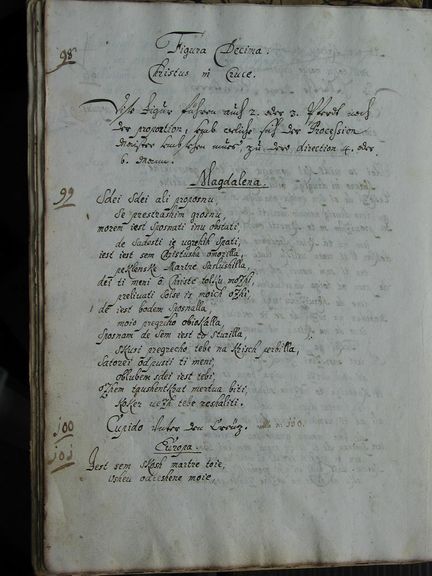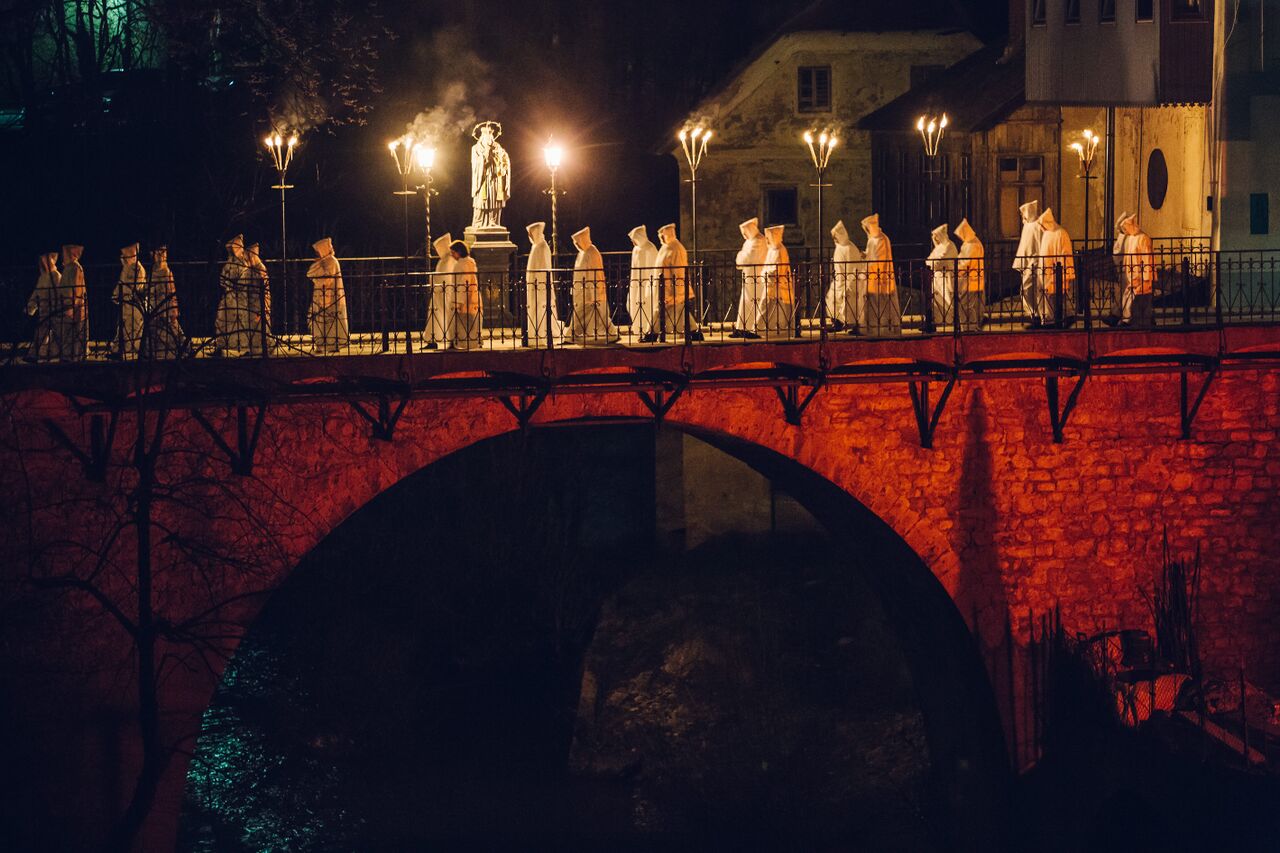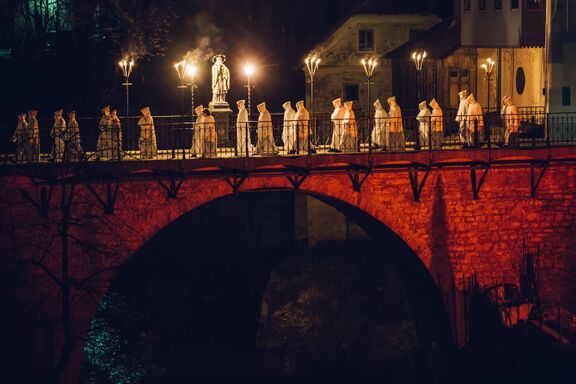Difference between revisions of "Škofja Loka Passion Play"
(Capucin -> Capuchin) |
|||
| Line 20: | Line 20: | ||
{{Image|SkPasijon18.JPG}} | {{Image|SkPasijon18.JPG}} | ||
| − | The original text of the ''[[Škofja Loka Passion Play]]'' by [[Friar Romuald]] (preserved at the [[ | + | The original text of the ''[[Škofja Loka Passion Play]]'' by [[Friar Romuald]] (preserved at the [[Capuchin Monastery Archives and Library, Škofja Loka]]) dates from 1721, making it the oldest Slovene dramatic text in existence. Fragments of the play were reconstructed in 1936 and 1965, but efforts by the Museum Society of Škofja Loka to reassemble the complete text did not begin in earnest until 1997, when the mayor of [[Municipality of Škofja Loka|Škofja Loka]] suggested a new staging of the play. Various organisational groups were formed and joined by experts on costume design, language, acting, vocal and instrumental music, overall image creation, cuisine, organisation and promotion. Group leaders recruited actors in individual villages, rehearsals were organised and the play was performed in [[established::1999]] and again in 2000. On each occasion 1,200 participants (640 local amateur actors, 80 horsemen, etc.) presented the ''Passion'' in four locations in Škofja Loka, to over 30,000 spectators. The latest ''Passion'' was performed in 2009 (800 actors, 80 horsemen, 24,000 spectators) and will be re-staged again only in 2015. |
The [[Municipality of Škofja Loka]] and the [[Ministry of Culture]] prepare the nomination for the Škofja Loka Passion Play to be inscribed on the UNESCO List of Intangible Cultural Heritage. | The [[Municipality of Škofja Loka]] and the [[Ministry of Culture]] prepare the nomination for the Škofja Loka Passion Play to be inscribed on the UNESCO List of Intangible Cultural Heritage. | ||
| Line 33: | Line 33: | ||
==Accompanying events== | ==Accompanying events== | ||
| − | In the non-Passion years the [[Loka Museum, Škofja Loka|Loka Museum]] and the Museum Society of Škofja Loka have organised regular exhibitions and concerts relating to the time when the Passion Play was created. In 2007 the original text (preserved at the [[ | + | In the non-Passion years the [[Loka Museum, Škofja Loka|Loka Museum]] and the Museum Society of Škofja Loka have organised regular exhibitions and concerts relating to the time when the Passion Play was created. In 2007 the original text (preserved at the [[Capuchin Monastery Archives and Library, Škofja Loka]]) and other documents relating to the ''Škofja Loka Passion Play'' were exhibited in a church in central Zagreb. In 2010 [[Municipality of Škofja Loka]] organises thematic exhibitions, concerts and workshops locally, as well as internationally (photographic exhibition in Kyoto, Japan, and in Pecs, Hungary). |
In May 2007 the Museum Society of Škofja Loka also participated for the first time in the assembly of the Europassion Association, an organisation which brings together 70 European cities that are seeking to revive the passion play. | In May 2007 the Museum Society of Škofja Loka also participated for the first time in the assembly of the Europassion Association, an organisation which brings together 70 European cities that are seeking to revive the passion play. | ||
| Line 39: | Line 39: | ||
==See also== | ==See also== | ||
* [[Municipality of Škofja Loka]] | * [[Municipality of Škofja Loka]] | ||
| − | * [[ | + | * [[Capuchin Monastery Archives and Library, Škofja Loka]] |
* [[Loka Museum, Škofja Loka]] | * [[Loka Museum, Škofja Loka]] | ||
Revision as of 21:35, 14 October 2011
The play
The Škofja Loka Passion Play is a blend of medieval and Baroque mystery and morality plays, all that now remains of the European medieval penitent procession tradition. Since it was originally performed during the Baroque period, it has some Baroque characteristics, most typically Baroque images and allegories.
The play originally comprised 13 images, some of which were spoken and mimed explanations of the action. Today there are 20 scenes, but the order of events remains more or less the same, apart from a few minor changes. The language is original, with a few translations of words which are unfamiliar to today's listeners. Commentaries on the original, written as a framework for the play in German, were added to connect the scenes. Since there are no musical sources in the original, the music was written especially for contemporary performances.
Accompanying events
In the non-Passion years the Loka Museum and the Museum Society of Škofja Loka have organised regular exhibitions and concerts relating to the time when the Passion Play was created. In 2007 the original text (preserved at the Capuchin Monastery Archives and Library, Škofja Loka) and other documents relating to the Škofja Loka Passion Play were exhibited in a church in central Zagreb. In 2010 Municipality of Škofja Loka organises thematic exhibitions, concerts and workshops locally, as well as internationally (photographic exhibition in Kyoto, Japan, and in Pecs, Hungary).
In May 2007 the Museum Society of Škofja Loka also participated for the first time in the assembly of the Europassion Association, an organisation which brings together 70 European cities that are seeking to revive the passion play.
See also
- Municipality of Škofja Loka
- Capuchin Monastery Archives and Library, Škofja Loka
- Loka Museum, Škofja Loka
External links
- Škofja Loka Passion Play website (in several languages)
- Announcement for 2015 Passion Play
- Europassion Association's website
- Škofja Loka Passion Play faksimile at DLib.si
- The UNESCO Intangible Cultural Heritage List





